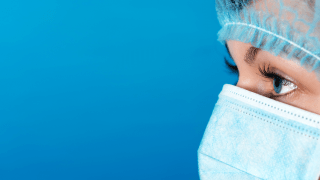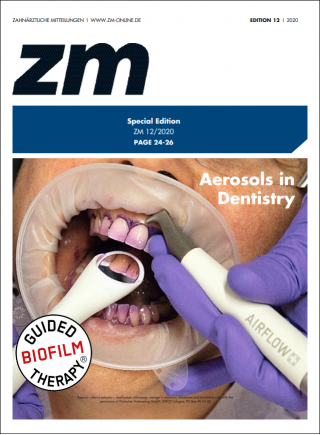COVID-19: 치과 치료의 에어로졸
SARS-COV-2 바이러스의 확산은 치과 치료에 큰 어려움이 되고 있습니다.
에어로졸은 건강을 위협하는 요소가 될 수 있습니다. 목, 코, 인후에서 바이러스가 발견되기 때문입니다. EMS는 에어로졸에 관련한 유용한 정보를 여러분께 전해드리려고 합니다.
주요 감염 경로는 비말 감염입니다1 . 최근 연구에 따르면 SARS-CoV-2 바이러스는 일반적인 상황에서 에어로졸을 통해 감염될 가능성이 있다고 합니다. 하지만 최종 컨센서스는 현재 단계에서2 어려워 보입니다. 에어로졸은 방울에서 스프레이까지 다양합니다. 50μm 이하의 작은 입자 크기 때문에 에어로졸은 수 미터까지 날아갈 수 있고, 방 안의 공기 중에 30분까지 잔류할 수 있습니다3 .
치과 에어로졸에 의한 감염을 어떻게 줄일까?
치료 전 클로르헥시딘A (CHX) 용액으로 구강 세정을 30-60초 시행하면 에어로졸에 섞여 나오는 박테리아의 양을 70%까지 줄일 수 있다4,5,6
CHX와 CPC, 또는 포비돈 아이오딘7,8이 포함된 구강 세정제는 박테리아와 코로나 바이러스(SARS-CoV-2)에 효과가 있는 것으로 나타납니다. 모든 치료 전 환자 구강을 60초 동안 박터X(CHX 0.1% 및 CPC 0.05%)로 가글할 것을 권장합니다.9
CPC: 세틸피리디늄 클로라이드
CHX: 클로르헥시딘
입과 코를 보호하는 마스크, 고글, 페이스 쉴드를 정확하게 사용하고, 기구를 확실하고 안전하게 멸균하는 것은 필수입니다. 에어플로우®와 피에존® 핸드피스 및 PS 팁을 매 치료 후 멸균하여야 합니다. 표면 세척과 석션 시스템의 주기적인 클리닝도 추가로 필요합니다. 매 치료 후 환기를 적절하게 하는 것은 강력하게 권장됩니다11 .
에어로졸의 생성을 어떻게 줄일까?
거의 모든 치과의 진료 기구는 에어로졸을 발생시킵니다. 여기에는 고속 핸드피스, 저속 핸드피스, 모터, 음파/초음파 장비, 시린지, 에어폴리싱 장비 등이 있습니다12 . 하이배큠 석션(최소 300L/분)과 살리바 이젝터를 함께 사용하면 에어로졸의 생성을 효과적으로 줄일 수 있습니다12,13 . 어시스트가 함께 진료하면 석션의 효과를 최적으로 유지할 수 있습니다14 . 술자 단독으로 전문가에 의한 기계적 바이오필름 제거를 시행할 때, 석션 테크닉을 숙지하고 옵트라게이트® 등 개구기를 사용하면 에어로졸의 발생을 줄일 수 있습니다.
추가 정보 및 권장사항
SARS-CoV-2 바이러스의 위협은 오래 지속할 것입니다. 바이오필름도 마찬가지입니다. 치과 전문가 여러분께서 EMS의 GBT(Guided Biofilm Therapy)와 함께 환자에게 즐거움을 전해주시기 바랍니다.
건강이 최고의 가치입니다.
건강에 유념하시기 바랍니다.
2020년 4월 29일




Prof. M. Mensi Prof. em. Dr. med. dent Dr. med. dent. Dr. med. dent.
DDS, Dipl. Chem. Ing. ETH S. Wildgen K. D. Bastendorf
Brescia Adrian Lussi Munich Eislingen
Bern
B. «Dental treatment: No increased risk in dental practices despite Covid-19».
2. https://www.rki.de/DE/Content/InfAZ/N/Neuartiges_Coronavirus/Steckbrief.html
11. Izzetti R, Nisi M, Gabriele M, Graziani F (2020) COVID-19 Transmission in Dental Practice: Brief Review of Preventive Measures in Italy. J Dent Res 17:22034520920580. doi: 10.1177/0022034520920580
'Prevent & Protect' 웨비나의 최신 버전을 확인해보세요! 녹화된 웨비나를 통해 COVID-19 상황인 현재와 추후 회복 단계에서 우리 치과에 사용할 수 있는 새로운 전략과 인사이트 및 전술을 알아보세요.
COVID-19의 위기에서 non-surgical periodontology 관리하기




